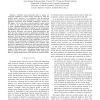Free Online Productivity Tools
i2Speak
i2Symbol
i2OCR
iTex2Img
iWeb2Print
iWeb2Shot
i2Type
iPdf2Split
iPdf2Merge
i2Bopomofo
i2Arabic
i2Style
i2Image
i2PDF
iLatex2Rtf
Sci2ools
INFOCOM
2010
IEEE
2010
IEEE
Optimal SINR-based Random Access
— Random access protocols, such as Aloha, are commonly modeled in wireless ad-hoc networks by using the protocol model. However, it is well-known that the protocol model is not accurate and particularly it cannot account for aggregate interference from multiple interference sources. In this paper, we use the more accurate physical model, which is based on the signal-to-interference-plus-noise-ratio (SINR), to study optimization-based design in wireless random access systems, where the optimization variables are the transmission probabilities of the users. We focus on throughput maximization, fair resource allocation, and network utility maximization, and show that they entail non-convex optimization problems if the physical model is adopted. We propose two schemes to solve these problems. The first design is centralized and leads to the global optimal solution using a sum-of-squares technique. However, due to its complexity, this approach is only applicable to small-scale networks. ...
| Added | 28 Jan 2011 |
| Updated | 28 Jan 2011 |
| Type | Journal |
| Year | 2010 |
| Where | INFOCOM |
| Authors | Amir Hamed Mohsenian Rad, Vincent W. S. Wong, Robert Schober |
Comments (0)

